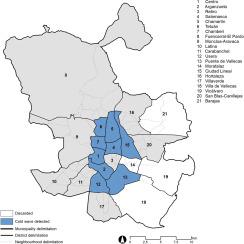Science of the Total Environment ( IF 9.8 ) Pub Date : 2020-09-15 , DOI: 10.1016/j.scitotenv.2020.142364 J.A. López-Bueno , C. Linares , C. Sánchez-Guevara , G.S. Martinez , I.J. Mirón , M. Núñez-Peiró , I. Valero , J. Díaz

|
While there is much research that focuses on the association between cold waves and their impacts on daily mortality at the city level, few analyze the impact related to social context and demographic variables at levels lower than the municipal. The objective of this study was to determine the role of the percentage of people over age 65, income level and percentage of homes without heating in the analysis of the impact of cold waves on daily mortality between January 1, 2010 and December 31, 2013 in different districts of the municipality of Madrid. We calculated Relative Risks (RR) and Attributable Risks (RA) for each of 17 districts to determine correlations between the effect of cold waves and daily mortality due to natural causes (CIEX: A00-R99) using Generalized Linear Models (GLM) of the Poisson family (link log). The pattern of risks obtained by district was analyzed using binomial family models (link logit), considering socioeconomic and demographic variables. In terms of results, an impact of cold on mortality was detected in 9 of the 17 districts analyzed. The analysis of risk patterns revealed that the probability of detecting an impact in a district increases in a statistically significant way (p-value <0.05) with a higher percentage of homes without heating systems and a higher percentage of population over age 65. The results obtained identify the factors that should be considered in public health policies that target the district level to reduce the impact of cold waves.
中文翻译:

考虑社会人口统计学变量的冷浪对马德里各地区每日死亡率的影响
尽管有许多研究着重于冷浪及其对城市一级每日死亡率的影响之间的关系,但很少有人分析与社会环境和低于城市水平的人口统计学变量有关的影响。这项研究的目的是确定在分析2010年1月1日至2013年12月31日之间的寒潮对每日死亡率的影响中,分析65岁以上人口百分比,收入水平和没有暖气的房屋百分比的作用。马德里市的不同地区。我们计算了17个地区的每个地区的相对风险(RR)和归因风险(RA),以使用以下方法的广义线性模型(GLM)确定冷浪的影响与自然原因引起的每日死亡率(CIEX:A00-R99)之间的相关性。泊松家族(链接日志)。考虑社会经济和人口变量,使用二项式家庭模型(链接logit)分析了各地区获得的风险模式。根据结果,在所分析的17个地区中有9个地区检测到了寒冷对死亡率的影响。风险模式的分析表明,发现区域影响的可能性以统计学上显着的方式增加(p值<0.05),而没有供暖系统的房屋百分比更高,并且65岁以上人口的百分比更高。结果获得的信息确定了针对地区水平以减少冷浪影响的公共卫生政策中应考虑的因素。在所分析的17个地区中,有9个地区发现了寒冷对死亡率的影响。风险模式的分析表明,发现区域影响的可能性以统计学上显着的方式增加(p值<0.05),而没有供暖系统的房屋百分比更高,并且65岁以上人口的百分比更高。结果获得的信息确定了针对地区水平以减少冷浪影响的公共卫生政策中应考虑的因素。在所分析的17个地区中,有9个地区发现了寒冷对死亡率的影响。风险模式的分析表明,发现区域影响的可能性以统计学上显着的方式增加(p值<0.05),而没有供暖系统的房屋百分比更高,并且65岁以上人口的百分比更高。结果获得的信息确定了针对地区水平以减少冷浪影响的公共卫生政策中应考虑的因素。



























 京公网安备 11010802027423号
京公网安备 11010802027423号